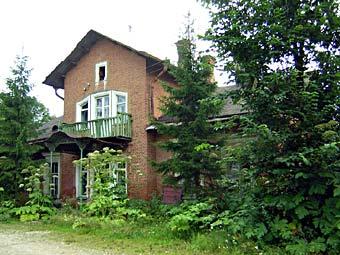Articles
/
Ust-Ruditsa, a country estate
Ust-Ruditsa, a country estate
Subject /
Architecture/Country estates
Ust-Ruditsa, a country estate (the Lomonosov district). In 1753 Empress Elizabeth Petrovna granted a grange and 4 villages in the Koporye uyezd to M.V. Lomonosov for building the estate and a factory of colour glass. Choosing the place at the watershed of three rivers (the Ruditsa, the Chernaya, the Kovashi) was determined with the abundance of running water and the availability of sand that is suitable for glass making. The dam, built on the River Ruditsa, gave the opportunity to make the big weir - high water which became the centre of the estate and factory complex composition. All factory constructions (kilns, a mill, a saw-mill) were placed on the left bank of the weir, the estate buildings (the one-storied wwden manor-house with attic and service buildings) were located on the right bank. Nearby the manor-house there were two wings. In the left wing there was a research laboratory where the technology of producing different sorts of glass, glassbeads, mosaic was developed; in the right wing there was a workshop where polishers and mosaic maker worked. The laboratory equipment was made on the models created by M.L. Lomonosov. The factory generally produced opaque colour glass for "mosaic pictures" and different adornments. In 1753-1765 twenty seven portraits including "Poltavskaya bitva" ("The Battle of Poltava") (now it is placed in the building of the St. Petersburg Academy of Sciences) were made of mosaic glass produced in the factory. In some years after M.V. Lomonosov's death, in 1768, the producing of grass was stopped, the factory was closed. The estate was inherited by Lomonosov's heirs: the Konstantinovs, the Rayevskys, the Orlovs. The estate was reequiped more than once, a wooden manor house, stone service buildings, greenhouses were built, the "English" park was laid out, service buildings were moved onto the River Chernaya bank. The estate buildings are not intacted. In 1959 the place, where the factory was located, was declared the Russian science and technology monument and taken under the state protection and memorial obelisk was constructed. In the 1950s fragments of glass were found out during the archeological dig on the place where the factory was located. The research of these fragments allowed to restore the technology of glass making. A model of the estate is kept in the State Museum of the History of St. Petersburg.
Authors
Chekanova, Olga Aleksandrovna
Persons
Elizabeth Petrovna, Empress
Konstantinovs, the
Lomonosov, Mikhail Vasilyevich
Orlovs, The
Raevskys, the
Geography
Topographical landmarks/Chyornaya River, the
Topographical landmarks/Kovashi River, the
Leningrad Oblast, the/Lomonosov District
Topographical landmarks/Ruditsa River, the
Bibliography
Лихоткин Г.А. Ломоносов в Петербурге. Л., 1981
Белявский М.Г. Все испытал и все проник. М., 1986
Мурашова Н.В., Мыслина Л.П. Дворянские усадьбы Санкт-Петербургской губернии. Ломоносовский район. СПб., 1999., 154-156
Mentioned in articles:
|
hidden
|
Country estates
Country estates. In the early 20th century on the territory of the modern Leningrad Oblast there were 2000 country estates. Mainly they appeared at one time with St. Petersburg. There were not many "Family nests" that belonged to one family and... more
|
|
|
|
hidden
|
Lomonosov District
LOMONOSOV DISTRICT. Area: 1990.8 sq. km. Population: 65,300. Established in 1927. L. D. comprises Bolshaya Izhora and Lebyazhye urban settlements and 140 rural localities. It borders St. Petersburg and Kingisepp, Volosovo, and Gatchina Districts of... more
|
|
|
|
hidden
|
Lomonosov, Mikhail Vasilyevich (1711-1765), a scientist, literary man
Lomonosov, Mikhail Vasilyevich (1711-1765), a scientist, poet, enlightener, honorary member of the Academy of Arts (1763). Lomonosov learned at the Slavonic-Greek-Latin Academy in Moscow during 1731-1735, from 1735 he learned at the Academic... more
|
|
|
|








